Dear Artist,
A recent study has determined that status-quo bias – the type of cognitive bias that keeps people preferring that things stay the same so as to reduce uncertainty – makes it harder to encourage or even recognize creativity. The conundrum, say scholars, is that it’s during times of uncertainty that we most need creative solutions. Dr. Jack Goncalo, professor of business at the University of Illinois at Urbana-Champaign has spent a decade studying implicit bias – our pre-reflective attributions of values and qualities – and its effect on our appreciation of imagination, inventiveness and problem-solving. According to Dr. Goncalo and his colleagues, thinking about God, an example of implicit bias, can activate a mindset of passive followership, which “inhibits the creativity of believers.”
The irony is that regardless of where we sit on the believer scale, what we say we think about creativity, and how we really feel about it are not the same. “We have an implicit belief the status quo is safe,” says researcher Jennifer Mueller, professor of management at the University of San Diego. She surveyed groups to get a baseline on their explicit thoughts on creativity. Then, tapped into their subconscious feelings with an implicit association test. This test placed words attributed to creativity (and its opposites) next to positive and negative words. Turns out, we’re all a bit hard-wired to be threatened by new ideas, even if we say we want them. It’s why established organizations struggle to adapt to change. “Novel ideas have almost no upside for a middle manager — almost none,” says Dr. Mueller. “The goal of a middle manager is meeting metrics of an existing paradigm.”
I’ve noticed in art – at least when witnessing audiences discover it, and in discovering it myself – that wonder blossoms from experiencing a magic something that straddles what is simultaneously new and deeply familiar. As human beings, we live in a language of connection and context. In art, we look for threads, and insert ourselves in its narratives and meaning. What we recognize has value to us – it’s why the composer gives us an overture – a taste of themes and motifs to come – before laying on us, the symphony. It’s why in advertising, frequency and reach are the insidious Trojan horses of compliance and consumerism. It’s why all but the most dare-devil collector must often experience your work in three or four different contexts – online, in a magazine review at the doctor’s office, in a gallery show, in a friend’s dining room at a dinner party – before they’re convinced to bite the bullet. It’s why we’re chronically yoked to a pernicious implicit bias against the foreign; our tribalism siloing us into cultural cannons, writing histories that mirror our own unthreatening reflections.
Sincerely,
Sara
PS: “People actually have strong associations between the concept of creativity and other negative associations like vomit and poison.” (Jack Goncalo, professor of business at the University of Illinois at Urbana-Champaign)
Esoterica: If your duty as a creative person were not challenging enough as a venture in uncertainty, know now that you are also wing-walking against your own personal implicit bias towards the familiar, plus the world at large’s hard-wired aversion to your presentation of the unknown. There is a reason why almost everything created today is considered, in some way, simply derivative. It is not just that there is so much to draw from and be inspired by. We are fighting against, and working within the irresistible attraction to our own aesthetic histories. But we are also all part of a collective inquiry into the mysteries of being alive. I consider myself and my explorations, — a grain of sand in an ocean floor of human wonder and curiosity. I also release myself from the fool’s errand of the slog of chasing novelty. Novelty for its own sake is a distraction from the pursuit of a connected human wonder. “The basic project of art is always to make the world whole and comprehensible,” wrote Robert Hughes in his 1980 overview of Modern Art, The Shock of the New. “To restore it to us in all its glory and its occasional nastiness, not through argument but through feeling, and then to close the gap between you and everything that is not you, and in this way pass from feeling to meaning.”
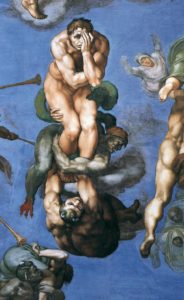 Have you considered a Premium Artist Listing? With each letter, an artist is featured at the bottom of this page. The Premium Artist Listings are a means of connecting artist subscribers through their work. Proceeds from each listing contribute to the production of The Painter’s Keys.
Have you considered a Premium Artist Listing? With each letter, an artist is featured at the bottom of this page. The Premium Artist Listings are a means of connecting artist subscribers through their work. Proceeds from each listing contribute to the production of The Painter’s Keys.
“[Art is] not something that committees can do. It’s not a task achieved by groups or by movements. It’s done by individuals, each person mediating in some way between a sense of history and an experience of the world.” (Robert Hughes)
Featured Workshop
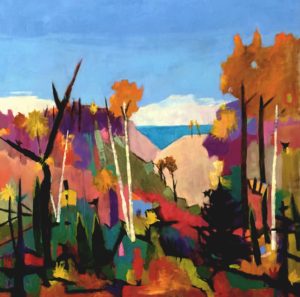 Permission to Paint Expressively Series Session 1
Permission to Paint Expressively Series Session 1
June 27-30, 2022
Join Ellie Harold for “Expressive Painting: Color from the Inside Out.” Do you struggle with color? For chromophobics or anyone who would like greater freedom in their use of color, this workshop focuses on activating and applying your innate color sense. Content, process and lightly structured exercises allow you access to a wider range of color expression in the safe space of Ellie’s studio, located only 3 blocks from Lake Michigan near Sleeping Bear Dunes. “Expressive Painting: Color from the Inside Out” has the potential to transform not only your art but your life! Details and registration at www.EllieHarold.com.
Featured Artist
As I examine my subject, I pull the colors out and reduce the lines. I take from the most interesting areas, placing sections into a cohesive composition of lines and areas of visual interest. I am currently working on a tree bark series examining the details of diseased areas, breaks, patterns, and scars. My goal is to create an interpretation of the way I respond emotionally to my subjects through the use of color and line. The tree bark series is an autobiographical metaphor to express the experience of childhood abuse, recovery, and victory.

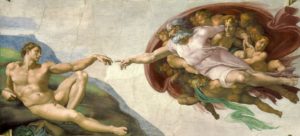
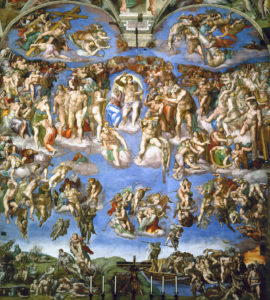
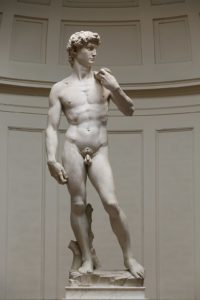
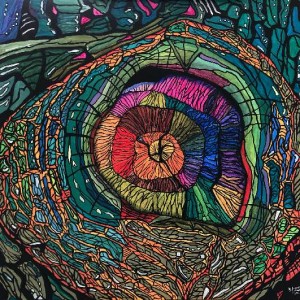



25 Comments
If the mind thinks enough of itself, it will reach out to find another path to understanding. For some the brush is wet and needs to land somewhere familiar or somewhere not. We do what we need to do, and that is fine. Thanks.
Great post, it made me think of flow and the constant search for meaning. I find myself balancing between familiarity (devolving into boredom) and innovation (escalating into chaos).
In college we studied G.W.F. Hegel. What was posited was that any great man must not be judged by ordinary history – that they must stand outside of history. I called bullshit then and I call bullshit now. Here’s why.
I am a Christian. I have a deep comfort with God handling things I can not see any human way to handle and getting a good outcome. With 65+ years of experience when I look back I can see where what I thought was “The End” was actually a spring board to even better things.
Having established my belief in God I will now establish why I disagree with Dr. Goncalo. I walk into situations with all of this experience and, if something is not working, will not hesitate to break it down into First Principles and then rebuild it. The words “But this is how we have always done it!” are a call to action to disrupt and innovate! Fearing change when you are in a broken situation is the dumbest thing you can ever do! If you don’t change, you will keep getting the same result. What is the definition of Insanity? Say it with me! “Insanity is doing the same thing over and over again and expecting what? Different Results!”
DON’T FEAR (ah yes – F.E.A.R. – Future Expectations Appearing Real) change!
I will leave you with this – ask yourself, honestly, how many times your worst fears have actually come true. Everyone I have spoken to will admit that their worst fears ALMOST NEVER come to pass and a huge amount of time was wasted worrying over those fears. LIVE PEOPLE! Your clock is ticking and I can tell you that my only regrets are the things I HAVEN’T done (YET!).
And that’s why worrying works! The more one worries the more that situation or thing may not happen. When it does not happen, bingo . . . the worrying worked. I also have deep comfort in Santa Claus watching me in every single thing I do 24/7. He knows.
And all of the energy spent on worrying could go toward creativity. Why waste time and put rust on the blade of your life?
OH boy this is good. A lthough I do take umbrage with worst fears not being realized – as early oon in my life the worst fear of losing everything happened and I must admit I have hadd some trouble with a faith – even as I am loathe to relinqquish it. I also see times when I doubted and should have stepped out on tissue paper and found I was on solid ground. What does God make of us?
I couldn’t agree more with your perspective. My worst fears have never materialized! I shall trust in God to open my mind to the possible and follow with confidence to embrace the adventure that lies ahead!
But isn’t the belief in a “God” one of the oldest ‘set in our ways” beliefs there is? Seems that one has difficulty talking about change and FEAR of change when invoking their beliefs in Christianity.
This letter makes the ongoing ‘reactionary’ push against progressive ideas and culture much more understandable. Thank you
Do I carry a bias toward the status quo in my own art? While I try hard to avoid copying myself, I am aware that I have to constantly work to keep from allowing my painting to go down familiar paths, to only explore familiar landmarks. Artists are often told to find creativity by letting their subconscious direct their work, but the subconscious is also affected by the status quo, so I may subconsciously end up replicating my own work or worse, some other artist’s work. I think the artist has to remain consciously active in the process to avoid slipping sideways into repetition.
When we look at other artists’ work over time, do we see growth or no growth? Are we critical of the status quo in their production without seeing it in our own?
A very good article, Sara!
Brilliant. I live in a retirement community with ages from late 50’s to late 90’s! We constantly run up against huge resistance to change, especially from those who’ve been here the longest. “We’ve always done it this way” is a recurring expression; frequently based on rules and societal regulations that are no longer at all relevant. It’s exhausting. Society has changed in the last 30 years, whether these folk know it or not. Sigh.
But not always for the better.
All this intellectualizing…….. I’m going back to my easel.
So…. I wonder, if an artist who is represented by galleries and expected to paint what the collectors are buying, is what they are doing at the easel always a creative time spent, or a disciplined artist who knows how to live off sales of their work. I admit, I don’t always feel free and creative while I’m painting. I have a sense of what my style has evolved into and feel responsibility to continue on this path I am on. Not all ideas are different from each other. There is a sameness when looking at a grouping of my works. I do recall, however, a time years back when I did veer away from the way I was painting at that time, and made many messes, and told so, told to stop doing that, paint nice like you used to. I don’t ask those people for their opinions anymore, I just paint. :) Great newsletter, Sara, always good substance to ponder. Thank you!!
This seems like too binary an approach: people cling to the familiar vs. trying out new, creative ideas. Certainly it’s common to be stuck at either pole of the continuum. In my experience in living and art making, there’s an oscillation between the two.
Change can occur in a major impactful way or in subtle micro adjustments. I may push a new element in my painting then back track to the status quo. What I notice is how a new synthesis emerges over time that moves the work forward.
I’m reminded of the old adage, “Don’t throw the baby out with the bath water”.
Great letter, Sara….lots to ponder……I always appreciate your thoughts.
Great letter! Thank you Sara for continuing to bring such thought provoking content.
My take away? Michelangelo’s David is not circumcised. Another example of implicit bias.
I was reminded of the Annalee Newitz book “Four Lost Cities: A Secret History of the Urban Age”. “Americans Don’t Know What Urban Collapse Really Looks Like” is an interesting article over at The Atlantic for anyone interested!
Shazam! Anyone read (or, remember) the critical artistic discussion regarding figurative versus abstract Art, in letters published in 1957 between Miguel Otero Silva and Alejandro Otero, with a stipulation i.e. being “the need for a language to be constructed” ? -Ref: Alfredo Boulton and his Contemporaries, 1946 through 1974; The Challenge of our Times, copyright 1974.
Hi Sara. Thanks for a thought provoking letter. And, there were some good and some interesting comments. So, Goncalo says, paraphrasing, those who believe in God are “mindless”. Can you say stereotype and prejudice. Yet, you have people from across the globe who believe in God. It’s a diverse group. Even if you were to go to a local church, you would find different people, with different thoughts, who don’t all agree with each other. Go to a local cafe, where you like the food and the music. You will probably find more people there, with similar tastes as you, that will think like you. Still, going to be some there that don’t. Anyway, the artwork was good. Michelangelo was a great sculptor and painter. So was Leonardo da Vinci! Thanks for the letter, Sara.
Back in Michaelangelo and Tinteretto’s time, the major and only patron of the arts was the church. If you were a painter, you pretty much had to paint God, the Biblical stories, and all the religious mythology within or you would be out of a job. ( Goya managed to survive in a later time period by painting kings, dukes and various members of the aristocracy until he retreated to his cottage to paint on the walls, but that was another century).
So, back to God. Most artists were spiritual people, and standing in a Venetian church looking up at the dramatic interplay of light and dark, life and death, it isn’t hard to see how Tintoretto, for example, was a robust believer in the God that saved him from the plague and allowed him and his family to become wildly successful from a poor dyers son. Religion was a way up from the grinding poverty of the slums; the “men of God” were the art dealers and patrons of the arts of their day, so yes, lots of religious art was painted and lots of religious sculptures were made. This was a good thing. It’s a shame that the well heeled evangelical Christian and Catholic Churches today don’t spend more money on artists.
Would those artists of that time period have produced so much religious art if The Church had not been such a benevolent benefactor? Not all religious art is a beacon of creativity either. Call me a cynic, but even artists have to eat.
thanks
In fact, the idea of creativity is strongly associated with other negative connotations, such as poison and vomit. Regards from arborist christchurch!
We all speak a language of context and connection as humans. Regards from masonry team.